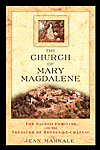
This book doesn’t even get to Mary Magdalene until chapter 9 (of eleven). Originally published in France in 1989 as Rennes-le-Château and the Enigma of the Cursed Gold [my translation], the book was no doubt renamed by the American publisher, which also publishes Margaret Starbird, so that Markale could ride on Dan Brown’s coattails. Markale, who lives in Brittany and is a Celtic specialist at the Sorbonne, is probably the world’s greatest expert on Celtic tradition, history, and folklore on the European continent. He is the author of forty books on Celtic mythology, the Templars and the Cathars, the prehistoric goddess, and medieval culture and spirituality. Brown is a popular writer; Markale is an authentic scholar.
What The Church of Mary Magdalene is really about is the shadows and mysteries surrounding Abbé (Father) Béranger Saunière, the priest who spent the years around the beginning of the 20th century redecorating the church and looking for treasure on the grounds, treasure that may have been either gold or historical documents. His search is said to have been directed by a secret society. He actually found some parchments, but no one knows what or where they are today. Markale does not actually debunk the Holy Blood/Holy Grail corpus, but he does say that reading parts of that famous book induced hysterical laughter. The so-called Priory of Sion documents, including the Merovingian genealogies, he points out, were deposited in the Bibliothèque Nationale in Paris by one Henri Lobineau, who turns out not to be a real person; the documents may have been written as a hoax by an actor.
The book, though fascinating, is not light reading. Markale uses over 200 pages to explicate the geography and history of Occitania (pronounced OX-ee-tania), which is the area of southern France near the Pyrenees through which the Visigoths traveled after they sacked Rome in 412, where the Cathars settled and were persecuted, where the king of northern France conducted the Albigensian Crusade in the early 13th century, and where Eleanor of Aquitaine lived. This is also where the Three Maries landed when they sailed from Jerusalem after the Crucifixion. Markale knows the history of the area, which maybe one in a thousand MTV-educated American readers know anything about. He also knows and explains the historical context of the late 19th century, a time when the Republicans were radicals who were trying to create the French Third Republic and the pretender to the French throne was not an imaginary Merovingian but a cantankerous old man who called himself Henri V. This was the Count of Chambord, whose widow gave money to Saunière, who was a fundamentalist monarchist who preached sermons on the restoration of the monarchy.
There are some unfortunate editing errors in the book. At one point, the Frankish king is said to have lived in 1507; when you’re recounting history, a thousand years is a large margin of error. At another point, “Aryan Christianity” is discussed. This is nonsense. What Markale actually wrote is Arian Christianity. In the 4th century, Bishop Arius and his theology were declared heretical by bishops who established orthodox Roman Catholic Christianity. The point is that the Visigoths were Arians and that heretics of all kinds have for two thousand years found refuge in Occitania.
Readers interested in things Celtic will be interested in Markale’s account of Abbé Boudet, priest at Rennes-le-Bains and mentor of Saunière. Boudet, who had earned a degree in English, is most famous for a book titled Le Vraie Langue Celtique (The True Celtic Language), in which he says that the Celtic language is the oldest language in the world and that the purest representative of this ancient Celtic language is modern English. Which may have been the language spoken in the Garden of Eden! Over a century ago, he took words that sort of sound alike and made them etymological cognates. Consider some of today’s metaphysical books. Some things never change.
Oh, yes—what about Mary Magdalene? Saunière redecorated his church with Marian symbolism. He built the Magdala Tower and named his villa the Bethania. Saunière’s “message,” Markale writes, “and he did have a message—specifically concerns Mary Magdalene whoever is concealed behind that name” (p. 259). Citing the four gospels, Markale says that she is the priestess who initiates Jesus with sacred oil. While Mary and Jesus may or may not have been husband and wife, she is very much like the Celtic triple goddesses who bring heroes to magical rebirth, and the “noli me tangere” scene, he writes “is of mythological, alchemical, metaphysical, and of course religious significance, all wonderfully combined in an image that can be engraved into collective memory” (pp. 266-7).
~review by Barbara Ardinger, Ph.D.
Author: Jean Markale, translated from the French by Jon Graham
Inner Traditions, 2004
